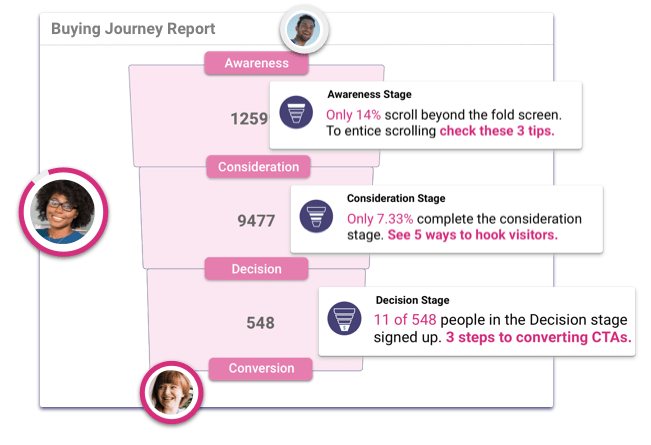Pathmonk Intelligence: Implement Change Suggestions With Confidence


The goal of Pathmonk Intelligence is to analyze the growth opportunities and buying journey on your website in order to generate suggestions on how to improve and get better results.
The truth is, it’s often hard to tell why your site doesn’t bring the expected results and how to change that. Even when you decide to run A/B tests and run checks with website metrics or heatmaps you will likely find yourself in doubts about what to actually change, thus a big challenge faced many marketers.
Pathmonk Intelligence analyzes the Buying Journeys of each of your website visitors. It reveals why leads are not converting and how to fix it, rather than just leaving you with inconclusive A/B testing results.
Why do Marketers use A/B Testing on Their Websites?
It is common for more than 98% of all website visitors to simply leave the website without completing the most important conversion goals, such as a demo request, click-to-calls, lead form fills, etc. So the vast majority of traffic that is generated through either paid or organic sources simply abandon the page.
The concept of website conversion optimization can be rather complex. That is why many marketers tackle the questions for higher website lead generation by running A/B tests on their websites.
Superficially, the process of A/B testing sounds good. But if you are constrained by time and budget you will have to radically simplify what you’re actually testing. As soon as you start to make these subjective choices you already introduce the first bias. Which of the 100+ possible variables on a simple website are you going to run through your A/B test?
The question becomes – how sure are you about the impact of the elements that you chose to test? Might you even be wasting your time with A/B testing?
Why do Marketers Struggle to Trust Their own A/B Test Results?
The industry average success rate of A/B tests sits somewhere around 12% to 15%. So in the vast majority of cases, the test doesn’t offer enough useful changes that you can make on your website. It’s too much effort for limited tangible results.
If you happen to create a test that suggests a positive change. It is very wise to check for the validity of your results before implementing anything on your website. It wouldn’t be the first time that an A/B test result implementation would do more harm than good.
Smart marketers know that in every A/B test they conduct, there is a probability of attaining wrong or misleading results. We won’t go too much into depth here on the pitfalls an A/B test can have. Instead, here is a quick overview:
- There’s a high chance that your test is completely misleading, even if you stop it as soon as it reaches 95% significance. In order to rule out seasonality, you often need to allow your test to run for a couple of weeks.
- Incremental tests on imagery or text often don’t bring you very far. If your test requires layout changes of dynamic elements, developer skills are required to implement such changes, that pretty much all A/B testing tools are not able to handle.
- The more variations you have the higher the likelihood that you get false results. If your test has up to 10 different variations, then your chance of getting a significant, but false result is already close to 50%!
A/B tests can be influenced by so many different factors. Even if your tests fall into the 12-15% of successful tests, the chances are that the uplift was imaginary and you won’t see an increase in revenue, once you implemented the suggestions.
What to do When you Have Low Traffic & Low Conversions?
According to A/B Tasty, you need to reach a minimum of 5000 unique visitors per variation and 100 conversions on each conversion goal by variation in order to run a test that makes sense. Anything less than that will result in an inefficient A/B test.
Some conversion rate experts go beyond, saying that you can only rely on A/B tests that have a minimum of 500 to 700 conversions per month.
So now – most lead gen marketers out there generate far less than 500-700 conversions per month. Nevertheless, they still need to improve their website somehow.
So what can you do instead…
A Better Way to Decide What to Change on Your Website.
We won’t make the claim that Pathmonk Metrics can solve all of your problems, but for the many marketers that have problems creating effective website changes, Buying Journey analysis is a much better solution than A/B testing.
Think about the changes that you did to your website in the recent weeks and months.
Often it’s single improvements, sometimes driven by A/B testing, that may result in a temporary uplift in your conversion rates. However, if you want to improve lead generation from your website in a significant and sustainable way, you need to look at the big picture: the full Buying Journey that visitors experience on your site.
This is especially relevant if you are selling something that requires some in-person explanation, new software, or specialized service. Any service or product that has a decision journey involved and buyers evaluate the options with care before even getting in touch, then understanding their whole journey can contribute to increased conversions.
The Buying Journey is the process that buyers go through to become aware of, consider, and decide to purchase your product or service:
- Stage 1 The Awareness stage: After a buyer realizes they have a problem or pain point they are eager to find a solution and begin discovering their options.
- Stage 2 The Consideration stage: Buyers have defined their goal and are committed to addressing it. They evaluate the specific offering and start to become willing to engage with businesses.
- Stage 3 Decision Stage: Buyers have already decided on a solution category. They have a profound understanding of specific offerings and need to decide on the one that best meets their needs.
How Pathmonk Intelligence Knows What Changes are Needed
Pathmonk Intelligence focuses on your website Buying Journey. We provide data that is impossible to get for Lead Gen Marketers with Google Analytics or Heatmaps.
Why?
Because Pathmonk analyses each step that website visitors take in their buying journey (every click, every scroll, every tab change, every revisit, etc,) This tool knows where people are in the Buying Journey and how far they are from making a decision, all thanks to Pathmonk’s AI.
Without having to set up any trigger events, reading into heatmap results, or watching countless user session videos, it tells you what you need to know to improve the Buying Journey on your website. It literally provides hands-on suggestions that tackle the specific bottlenecks on your website.
When you know why you’re losing leads and you know what you can do to tackle those challenges then you can improve the buying journey on your website. With Pathmonk Intelligence, you get all the buying journey data and actionable change suggestions at a glance so you can focus on creating a better Buying Journey for your visitors.
As you read this, Pathmonk’s AI is already learning from countless lead gen pages. SO once you plug it into your page you will immediately benefit from the AI suggestions without having to crunch numbers for countless hours to get to insights.
Request Free Pathmonk Intelligence Access and See for Yourself
Pathmonk Intelligence is a simple, time-saving metrics tool that goes beyond the standard insights by identifying the health of the buying journey on your website. It provides you with actionable suggestions so you can address the hidden bottlenecks on your site.
You don’t need to remove your current analytics provider but rather use Pathmonk Metrics alongside your other tools, see where you get the most actionable and impactful insights. Pathmonk Metrics is currently in beta, you spotted it early, request free access here.
Know Why Your Page Is Missing Results
Pathmonk Intelligence analyses the growth opportunities & user journey on your website, then generates suggestions on how to improve.






